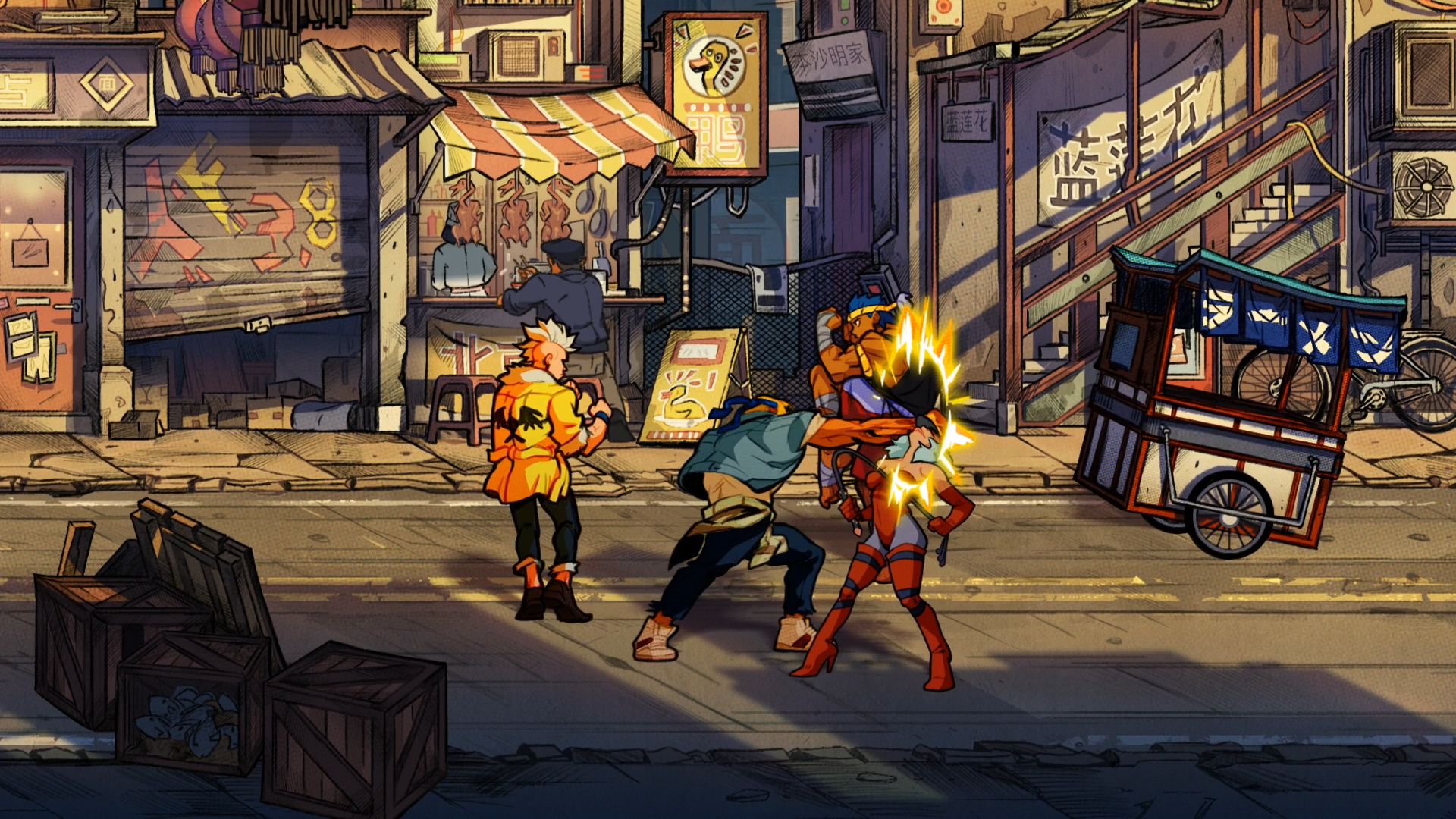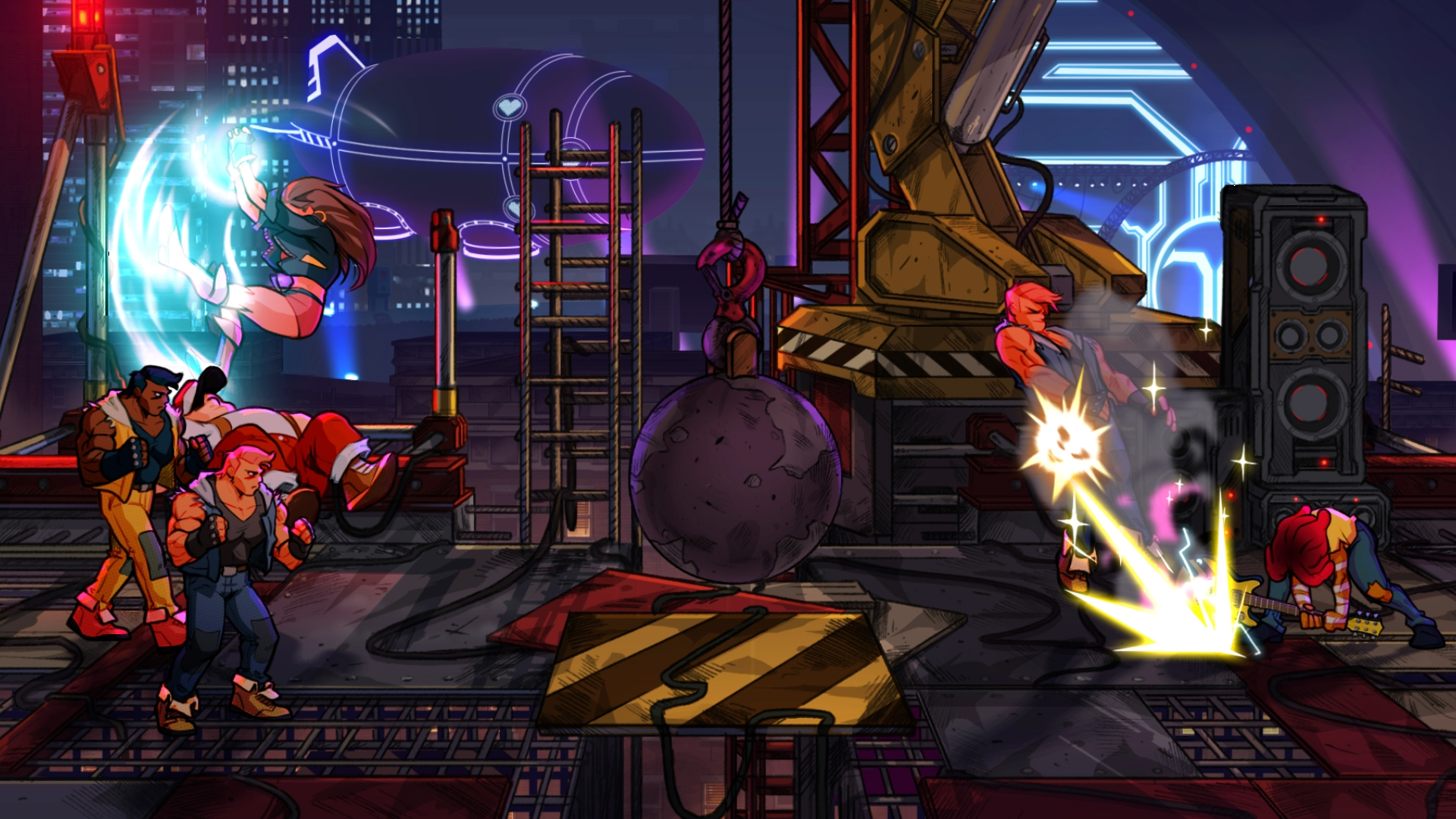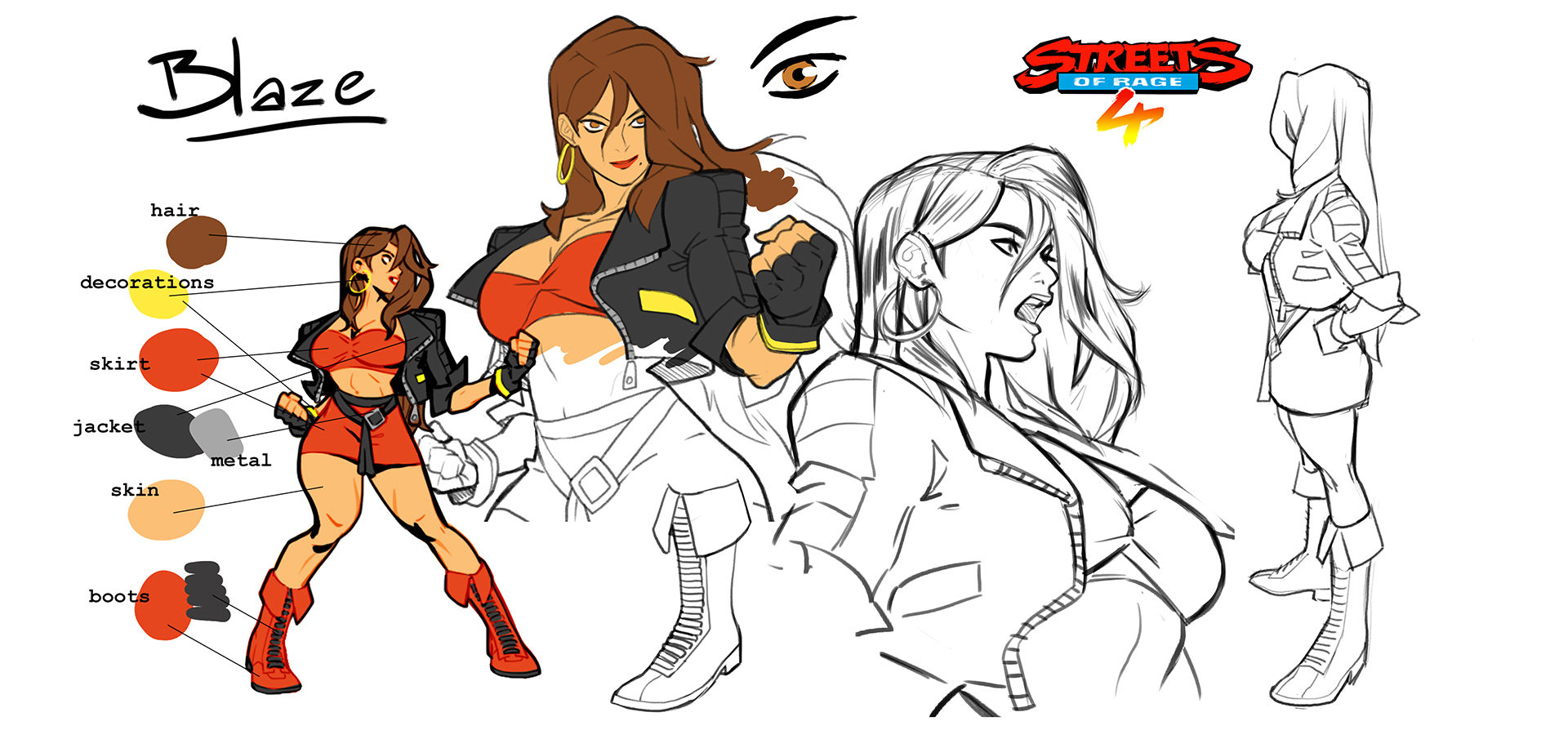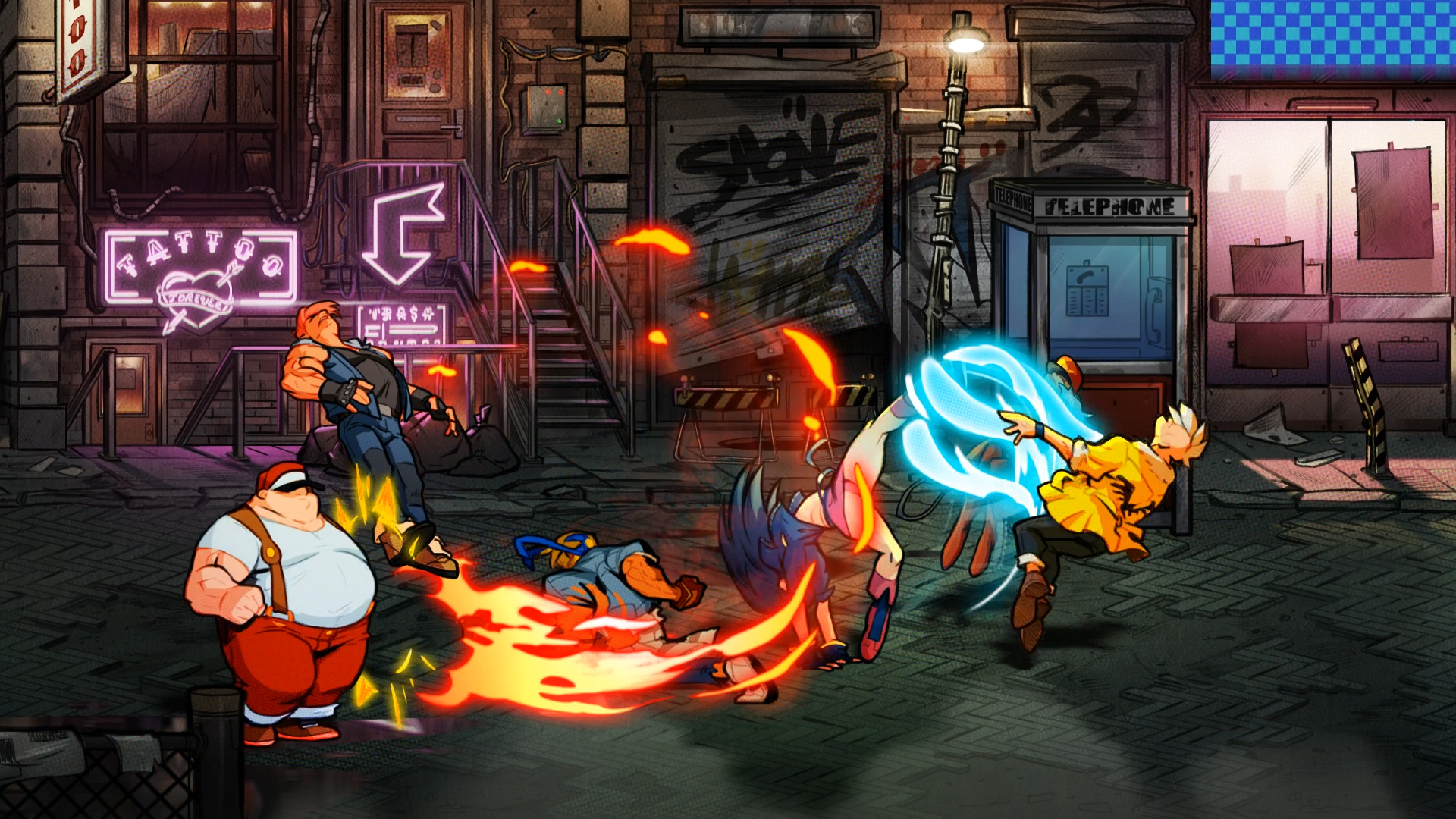I’m not sure I can pick out the exact moment in my life when I first fell wildly and irrevocably in love with video games, but, if you give me the chance to narrow it down to the top five, here’s one that definitely makes the cut. I was seven years old, hanging out at a friend’s house. After messing around a bit with the original Sonic trilogy on his then-ancient Sega Genesis, we popped in Streets of Rage. I remember sitting there, reading the deeply-melodramatic text-scroll that describes how the nefarious gun-toting “Mr. X” took over the city, with that melancholic synth drone punctuated by catchy arpeggios, and just thinking, yes. Forget Mario, forget Sonic. This is for adults. This is what video games can be.
It was the way the game boldly declared its neon-drenched aesthetic really stuck with me over the years. Even though I was well out of the typical age range for a Streets of Rage fan, I ended up playing all three on emulators later on as a teen, and appreciating them as one of the pinnacles of the beat-’em-up form, especially 2. However, it wasn’t an official Sega joint that got the majority of my playtime—rather, it was a little-known fangame called Streets of Rage Remake, which smashed together the series’ many levels and playable characters into a Mortal Kombat Trilogy–esque highlight reel. While the project was tragically removed from the developer’s website after Sega sent a cease-and-desist letter, it’s easy enough to find online even today. I remember reading that news and thinking: In an era where brawler revivals like Castle Crashers and Scott Pilgrim vs. The World light up the charts, why hasn’t Sega tried their hand at bringing this fan-favorite franchise back from the dead?
Well, it took almost 25 years, but a team of studios led by the French outfit Dotemu have finally managed to convince Sega to hand over the keys to this particular kingdom. While the game they’re calling Streets of Rage 4 doesn’t have a release date yet and is still early days, after playing a demo firsthand and juggling three foes in the air with a few button presses, it very much feels like a modern reimagining of the classic formula.

Like a lot of properties in Sega’s beloved back catalog, there have been many attempts to pitch a SoR follow-up over the years, some of which have leaked out into the aether. One even made it to store shelves: the now-forgotten 1997 beat-’em-up Fighting Force, which tried to translate the sprite-on-sprite fisticuffs of the genre into the third-dimension, with mixed success. According to an interview in Sega Saturn magazine, developer Core Design—best known for the Tomb Raider series—originally pitched the game to Sega as a next-gen take on SoR, only to be told that the publisher already had a potential entry in the works. Whatever that project was, it never materialized. More recently, in 2012, following a partial leak, Crackdown 2 developer Ruffian Games released a trailer for some sort of 3D SoR that never made it past the prototype stage. In the description, Ruffian studio head Gaz Liddon declines to speak any further on the trailer’s origins, but it seems quite unlikely that they would’ve prominently featured both the Streets of Rage name or fake Sega arcade machines if the famed publisher wasn’t involved in some capacity.
Dotemu CEO Cyrille Imbert admitted to me that Streets of Rage 4 is his company’s highest profile license to date, and one that Sega has been particularly protective of over the years. He cited the recent success of Sonic Mania, which was crafted by developers who had cut their teeth plugging away on high-quality fangames, as a turning point for not only Sega, but many licensees who are beginning to trust talented indie teams with their darlings of old. According to Imbert, the former console giant was especially impressed with Dotemu’s Wonder Boy: The Dragon’s Trap, which is in itself a remake of Wonder Boy 3, widely regarded as one of the best games for the less-successful Master System.
“There was an opportunity there to bring this game that many people like to a larger audience, and we were able to make that happen,” Imbert said. “I’ve always been a big Streets of Rage fan, played it a lot as a kid, and we had the right teams for it. Once we got the first concept art for it, we all got really excited. It was one of those moments where you can’t really believe it’s happening, you know?”

The name certainly inspires nostalgia in those who fondly recall blast processing, but as several team members attest, trying to tailor that style of game for a more modern audience has proven quite challenging. While there have been some successful attempts to return to the glory of the quarter-crunching days of yore—especially the aforementioned Castle Crashers—for the most part, the form has a reputation as a depleted fad that even lacks the hyper-nichization that has kept other “dead genres” from fading completely away, such as bullet-hell shmups. As main programmer Cyrille Lagarigue of Guard Crush Games put it, making a contemporary brawler means that you have to come up with solutions to classic problems that have plagued these games since Final Fight first popularized the concept.
When I was trying to become better at previous Streets of Rage games, I always found the strategies offered by guide writers (and later, speedrunners) to be rather difficult to grasp, and in some cases contrary to the game’s “go straight” ethos. For example, in order to avoid damage, you need to control your foes. Since you’re only able to stun-lock a foe when you’re in a combo, you should never hit a basic enemy with your combo-ender unless you’re absolutely sure that it’s going to take away their last chunk of health. As Lagarigue told me, that’s exactly the sort of unintuitive mechanic that they’re hoping to rectify. “I think the [new] juggling helps with that,” Lagarigue said. “You have a lot more options in this game, compared to the previous ones.”

Prior to Streets of Rage 4, Guard Crush’s most notable project was Streets of Fury, a well-regarded satire of the brawler genre that took a number of cues from fighting games. Streets of Fury’s characters each offered many moves, and the game relied on the rotoscoping of live-action footage to bring these characters to life, a la the original Mortal Kombat. When they finally got word that they would be able to work on a Streets of Rage sequel, both Lagarigue and fellow programmer Beausoleil Samson-Guillemette were absolutely ecstatic.
“Coming from an original project—where we just sort of tried everything we could, made something very crazy from Fatal Fury, other fighting games—to Streets of Rage was a huge shift. It’s the biggest franchise you can do a beat-‘em-up in, and we’re known as beat-‘em-up specialists now, so it was the right project at the right time,” Lagarigue said.
While their enthusiasm was certainly understandable, it required a fundamental realignment of their design philosophy. Instead of having the freedom to throw everything at the wall and seeing what worked, now they were messing with the fundamentals of a beloved franchise whose basic feel and mechanics are etched in the brains of an entire generation of players. For fans, even tiny changes would trigger a seismic shift.
Lagarigue recalled one such debate from early in development: In the original SoR trilogy, as with many brawlers, you grab enemies by simply walking up to them, which immediately puts them at a disadvantage. Some members of the design team felt that approach was too fiddly for a modern game, so they replaced it with a dedicated button. Over time, however, they realized that playtesters didn’t ever use the button, so they swapped it out, deeming the traditional method more intuitive. “It’s just so core to the franchise,” Lagarigue said. “When you have a grab button, some people will never use it.”

That’s not to say that Streets of Rage 4 is some ultra-faithful rehash—combos are now built around Tekken-style juggling, and nearly every special move launches enemies well into the air with a highly exploitable bounce when they land. Lagarigue and Samson-Guillemette also convinced the rest of the team to implement a dedicated “pick up” button, owing to the fact that they kept accidentally picking up vital, life-giving roasting turkeys when they meant to punch someone in the face. (This has the side effect of allowing you to throw a weapon at an enemy, wait for it to ricochet off their face, and catch it, which makes for a highly entertaining trick when you get the timing right.) “In the original games, you had to play really carefully, because you don’t want to accidentally pick up that turkey,” Lagarigue said. “It was the same button as attack. In the first implementation, we had that, but we were getting the same problems that existed in the past.”
The duo had a similar problem with the franchise’s traditional space-clearing “special moves,” which varied from entry to entry, but never quite worked to their satisfaction. After rounds of testing, they decided to go with a new spin on 2’s system, where you lose a bit of health each time you use it. Unlike in the older games, however, you can gain back that lost vitality by dealing damage, provided that you don’t get hit by an enemy in the process. “With that kind of system, even if it’s the perfect time to do the special attack, you feel like you lost, because you lose some life,” Lagarigue said. “We wanted to solve it with a Bloodborne-inspired system that said, okay, if you do it at the right moment, you can get the life back. It gives the game more of a skill system, where you can speedrun it.”
While Streets of Rage 4 still has a ways to go, based on the demo I can’t help but feel that the franchise is in safe hands with Dotemu and co. (I’m already planning to force another friend of mine to play it with me—we spent many hours together slogging through arcade classics on MAME back in high school.) But while fan expectations are high, Lagarigue said it best: “This is a big project for us, almost a dream. We just want to fulfill people’s expectations. Including ours.”

Steven T. Wright is a reporter and novelist living in the Twin Cities. He is the former independent games columnist for Variety, and he has written for Rolling Stone, Polygon, Vice, and many others. He almost named his novel after a city in Final Fantasy, but his friends talked him out of it.